Introduction
Published online by Cambridge University Press: 10 November 2009
Summary
The cosmological models proposed by A. Einstein and W. de Sitter in 1917, based on Einstein's theory of general relativity, initiated the modern study of cosmology. The concept of an expanding universe was introduced by A. Friedmann and G. Lemaître in the 1920s, and gained credence in the 1930s because of Hubble's observations of galaxies showing a systematic increase of redshift with distance, together with Eddington's proof of the instability of the Einstein static model. Since the 1940s the implications of following an expanding universe back in time have been systematically investigated, with an emphasis on four distinct epochs in the history of the universe:
(1) The galactic epoch, which is the period of time extending from galaxy formation to the present. This is the epoch that is most accessible to observation. During this period, matter in a cosmological model is usually idealized as a pressure–free perfect fluid, with galaxy clusters or galaxies acting as the particles of the fluid. The cosmic background radiation has negligible dynamic effect in this period.
(2) The pre–galactic epoch, during which matter is idealized as a gas, with the particles being the gas molecules, atoms, nuclei, or elementary particles at different times. The epoch is divided into a post–decoupling period, when matter and radiation evolve essentially independently, and a pre–decoupling period, when matter is ionized and is strongly interacting with radiation through Thomson scattering. The observed cosmic microwave background radiation is interpreted as evidence for the existence of this pre–decoupling period.
- Type
- Chapter
- Information
- Dynamical Systems in Cosmology , pp. 1 - 8Publisher: Cambridge University PressPrint publication year: 1997
- 1
- Cited by



